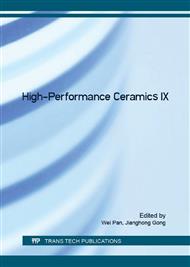[1]
A. Maximenko, G. Roebben, O. Van Der Biest, Modelling of metal-binder migration during liquid-phase sintering of graded cemented carbides, J. Mater. Process. Technol. 160 (2005) 361-369.
DOI: 10.1016/j.jmatprotec.2004.06.023
Google Scholar
[2]
W. Lengauer, K. Dreyer, Functionally graded haredmetals, J. Alloy. Compd. 338 (2002)194-212.
Google Scholar
[3]
U. Beste, T. Hartzell, H. Engqvist, N. Axen, Surface damage on cemented carbide rock-drill buttons, Wear. 249 (2001) 324-329.
DOI: 10.1016/s0043-1648(01)00553-1
Google Scholar
[4]
L.J. Prakash, Application of fine grained tungsten carbide based cemented carbides, Int. J. Refract. Met. H. 13 (1995) 257-264.
DOI: 10.1016/0263-4368(95)92672-7
Google Scholar
[5]
G. Gill, B. Szesny, K. Dreyer, H. van den Berg, J. Schmidt, T. Gestrich, G. Leitner, Submicron and ultrafine grained hardmetals for microdrills and metal cutting inserts, Int. J. Refract. Met. H. 20 (2002) 3-22.
DOI: 10.1016/s0263-4368(01)00066-x
Google Scholar
[6]
K. K Jangra, An experimental study for multi-pass cutting operation in wire electrical discharge machining of WC-5. 3% Co composite, Int. J. Adv. Manuf. Tech. 76 (2015) 971-982.
DOI: 10.1007/s00170-014-6218-4
Google Scholar
[7]
H.S. Chen, K.Q. Feng, S.F. Wei, J. Xiong, Z.X. Guo, H. Wang, Microstructure and properties of WC-Co/3Cr13 joints brazed using Ni electroplated interlayer, Int. J. Refract. Met. H. 33 (2012) 70-74.
DOI: 10.1016/j.ijrmhm.2012.02.018
Google Scholar
[8]
W.B. Lee, B.D. Kwon S.B. Jung, Effect of bonding time on joint properties of vacuum brazed WC-Co hard metal/carbon steel using stacked Cu and Ni alloy as insert metal, Mater. Sci. Technol. -lond. 20 (2004) 1474-1478.
DOI: 10.1179/026708304x4312
Google Scholar
[9]
P.Q. Xu, D. Ma, C.W. Ma. Analysis of WC Dissolution Phenomenon Happened in TIG Welded Joint of Cemented Carbide and Invar Alloy, Appl. Mech. Mate. 184-185 (2012) 896-899.
DOI: 10.4028/www.scientific.net/amm.184-185.896
Google Scholar
[10]
P.Q. Xu, X.J. Zhao, D.X. Yang,S. Yao, Study on filler metal (Ni-Fe-C) during GTAW of WC-30Co to 45 "carbon steel, J. Mater. Sci. 40 (2005) 6559-6564.
DOI: 10.1007/s10853-005-1547-1
Google Scholar
[11]
X.J. Zhao D.X. Yang, H. Wang, K.J. Takazawa, K.S. Tagashira, H.D. Yamamori, Microstructure of electron beam weld joints between cemented carbide YG 30 and carbon steel, Mater. Mech. Eng. 29 (2005) 21-26 (In Chinese).
Google Scholar
[12]
G.Q. Chen, B.G. Zhang, Z.Z. Wu, W. Mao, J.C. Feng, Int. J. Refract. Met. H. 24 (2013) 58-63.
Google Scholar
[13]
C. Barbatti,J. Garcia,G. Liedl, A. Pyzalla, Joining of cemented carbides to steel by laser beam welding, Materialwiss. Werkst. 38 (2007) 907-914.
DOI: 10.1002/mawe.200700196
Google Scholar
[14]
A.P. Costa, L. Quintino, M. Greitmann, Laser beam welding hard metals to steel, J. Mater. Process. Technol. 141 (2003) 163-173.
DOI: 10.1016/s0924-0136(02)00954-8
Google Scholar
[15]
A. Costa, R.M. Miranda, L. Quintino, Materials behavior in laser welding of hardmetals to steel, Mater. Manuf. Process. 21 (2006) 459-465.
DOI: 10.1080/10426910500471458
Google Scholar
[16]
M.I. Barrena, J.M. Gomez de Salazar, L. Matesanz, Interfacial microstructure and mechanical strength of WC–Co/90MnCrV8 cold work tool steel diffusion bonded joint with Cu/Ni electroplated interlayer, Mater. Design. 31 (2010) 3389-3394.
DOI: 10.1016/j.matdes.2010.01.050
Google Scholar
[17]
T. Iamboliev, S. Valkanov, and S. Atanasova, Microstructure embrittlement of hard metal-steel joint obtained under induction heating diffusion bonding, Int. J. Refract. Met. H. 37 (2013) 90-97.
DOI: 10.1016/j.ijrmhm.2012.10.021
Google Scholar
[18]
Y.G. Guo, B.X. Gao, G.W. Liu, T.T. Zhou, G.J. Qiao, Effect of temperature on the microstructure and bonding strength of partial transient liquid phase bonded WC-Co/40Cr joints using Ti/Ni/Ti interlayers, Int. J. Refract. Met. H. 51 (2015).
DOI: 10.1016/j.ijrmhm.2015.04.018
Google Scholar
[19]
P. Shen, X.H. Zheng, H.J. Liu, Q.C. Jiang, Wetting of WC by a Zr-base metallic glass-forming alloy, Mater. Chem. Phys. 139 (2013) 646-653.
DOI: 10.1016/j.matchemphys.2013.02.012
Google Scholar
[20]
Y.W. Zhao, Y.J. Wang, Y. Zhou, P. Shen, Reactive wetting and infiltration of polycrystalline WC by molten Zr2Cu alloy, Scripta Mater. 64 (2011) 229-232.
DOI: 10.1016/j.scriptamat.2010.10.018
Google Scholar
[21]
H. Bakar, ASM Handbook, Volume 3 Alloy Phase Diagrams, ASM international, Materials Park, Ohio, (1992).
Google Scholar


